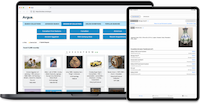Museum TrendsWatch 2024: Trend 3, Decarbonizing the Future

Rachael Cristine Woody
The Center for the Future of Museums (under the American Alliance of Museums) publishes a TrendsWatch report annually. The report includes topical deep dives and insight into emerging trends in the field.
With a combination of strategic foresight, global visioning, and keeping up with the latest in ethics and technology; the Center delivers content on wide ranging topics housed within a theme. This year the report theme is TrendsWatch: Navigating a Volatile Future and includes three main trends: Culture Wars 2.0, AI Adolescence in Museums, and Decarbonizing the Future. Then, in the pattern they adopted last year, a Short Take: Dropping the Degree; a For Your Radar: Digital Twins and Doom Loops; and a Trend Alert: Combatting the Loneliness Crisis.
This miniseries offers TrendsWatch snapshots to support distillation and application at museums. For our purposes we’ll cover each trend with a post. Today’s post will focus on Trend #3: Decarbonizing the Future. For this main trend I’ll provide a summary of the topic as presented by the Center (The Challenge section), how the trend shows up for museums (What This Means for Museums section), and the Center’s advice to museums (Museums Might). Throughout, I’ll offer analysis, insight, and tie-ins to related topics.
The Challenge
Of the many trends covered in TrendsWatch over the years, I would argue this trend is the most universally felt. Regardless of belief in it or what it’s called, climate chaos is increasing. In the introduction to this section Elizabeth Merritt, Founding Director of the Center for the Future of Museums, explains how The New York Times no longer use the term climate change and instead use “climate emergency” or “climate crisis” as it’s more accurate. She also lists and defines the many new terms that have arisen underneath the climate trauma header:
- Climate anxiety (a sense of impending dread)
- Solastalgia (distress at the changes in one’s home environment)
- Eco-grief (anguish and despair at the deterioration of the places we love)
What This Means for Museums
In addition to considering how museums might decarbonize, Merritt also asks: “How can [museums] inspire people to take meaningful action in response to the climate crisis, even as they prepare to live in a profoundly disrupted future?” As she rightly points out:
Of paramount concern is the fact that the climate crisis is harming the communities that museums exist to serve, posing particular risk to the very young and the very old, people with disabilities or chronic medical conditions, people of color, people with low incomes, and Indigenous peoples.
She then lists the risks to museums directly:
- More than 1/3 of museums lie within 100 kilometers of the coast and are at immediate risk to rising sea levels.
- 16% of Americans (and the museums that serve them) live in high-risk areas for wildfire.
- HVAC systems are struggling to keep up with extreme weather events and increased occurrences of (not so) natural disasters.
- Impact on botanical gardens and biological collections.
- Decrease in the number of outside events and event rentals.
- Increased insurance costs or even complete loss of coverage availability.
- Losing archaeological sites.
The TrendsWatch report then shifts into what museums can do with a focus on decreasing carbon output. However, the TrendsWatch report doesn’t cover the knowledge and resources museums need in order to realistically do so.
Museums Might (the advice section)
The following section is advice provided by Merritt for museums and their staff to consider. I’ve added in clarification and additional thoughts as applicable.
- Measure and report their carbon emissions.
- Set carbon goals and integrate them into the strategic plan.
- Implement policies that are also climate-friendly (with remote work suggested as an option).
- Explore what degrowth looks like for museums.
- Reconsider funding from sources fueling the climate crisis.
- Revisit decades long standards for climate control.
- Join museum + climate initiatives.
Conclusion
The two main actions of this trend are: 1. Offer climate education (and inspiration); and 2. Better control the museum carbon footprint. Both are areas where museums could benefit from increased knowledge and resources. In order to help this impactful work, granting agencies and donors will need to help fund it. Please join us for our next post on the TrendsWatch Short Take: Dropping the Degree.

Rachael Cristine Woody
Rachael Woody advises on museum strategies, digital museums, collections management, and grant writing for a wide variety of clients. She has authored several titles published by Lucidea Press, including her newest: Demystifying Data Preparation for a New CMS. Rachael is a regular contributor to the Think Clearly blog and always a popular presenter.
**Disclaimer: Any in-line promotional text does not imply Lucidea product endorsement by the author of this post.
Never miss another post. Subscribe today!
Similar Posts
No-Code Digital Storytelling Example: Rembrandt’s Self-Portrait at Kenwood House
Explore how English Heritage’s Kenwood House uses the no-code platform Shorthand to bring Rembrandt’s Self-Portrait with Two Circles to life through visual storytelling and interactive design.
Exploring No-Code Digital Storytelling: Hoover’s “Fanning the Flames” Exhibit
Explore no-code digital storytelling with Hoover’s ‘Fanning the Flames’ exhibit. See how interactive tools (Deep Zoom Color Compare & Hot Spot) enhance user engagement and the visual experience.
An Introduction to Scrollytelling for Museums
Discover how museums use scrollytelling and digital storytelling platforms to create immersive narratives. This introduction explores key concepts and approaches to interactive storytelling.
Exploring Self-Determinate Multiple Pathways: An Example of Digital Storytelling
Discover how self-determinate multiple pathways offer flexible interactive storytelling in museum exhibits. Learn from the Tenement Museum’s ‘Your Story Our Story.’







Leave a Comment
Comments are reviewed and must adhere to our comments policy.
0 Comments